InAppWebView: The Real Power of WebViews in Flutter
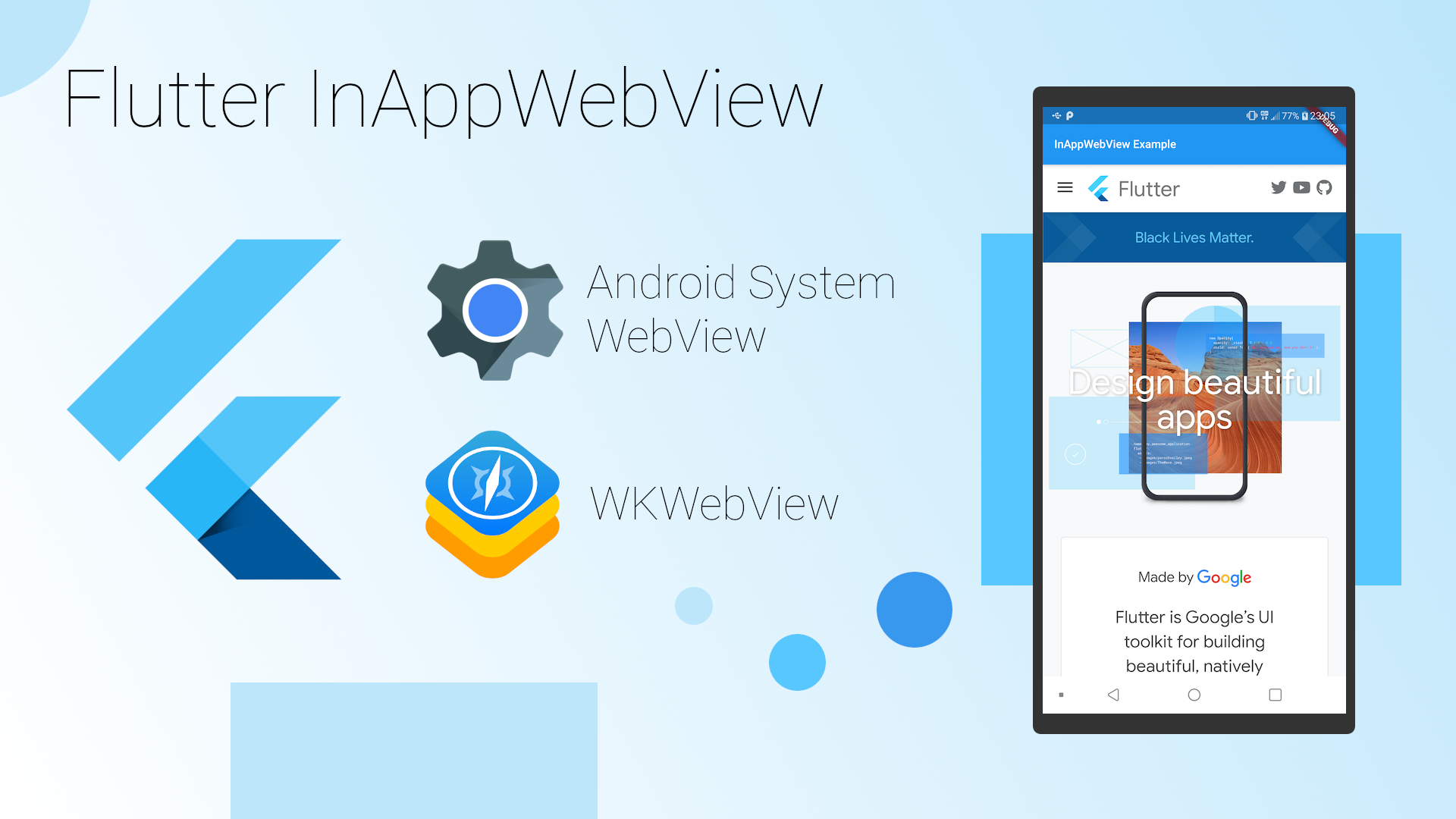
What is flutter_inappwebview? It's a Flutter plugin that allows you to incorporate WebView widgets into your Flutter app, to use headless WebViews, or to use In-App browsers.
So, what's the difference between webview_flutter (Official flutter plugin) or flutter_webview_plugin?
Compared to all other WebView plugins, it is feature-rich: a lot of events, methods, and options to control WebViews. Furthermore, they do not have good documentation about their API or, at least, it is not complete. Instead, every feature of flutter_inappwebview is almost all documented (just check the API Reference on pub.dev).
In this article, I'm going to present the main classes and some examples of the InAppWebView widget that people were asking about on the official flutter_inappwebview repository (issue section) and on StackOverflow.
Main Classes Overview
This is a list of the main classes that the plugin offers:
- InAppWebView: Flutter Widget for adding an inline native WebView integrated into the flutter widget tree.
- ContextMenu: This class represents the WebView context menu.
- HeadlessInAppWebView: Class that represents a WebView in headless mode. It can be used to run a WebView in background without attaching an
InAppWebViewto the widget tree. - InAppBrowser: In-App Browser using native WebView.
- ChromeSafariBrowser: In-App Browser using Chrome Custom Tabs on Android / SFSafariViewController on iOS.
- InAppLocalhostServer: This class allows you to create a simple server on
http://localhost:[port]/. The defaultportvalue is8080. - CookieManager: This class implements a singleton object (shared instance) that manages the cookies used by WebView instances.
- HttpAuthCredentialDatabase: This class implements a singleton object (shared instance) which manages the shared HTTP auth credentials cache.
- WebStorageManager: This class implements a singleton object (shared instance) which manages the web storage used by WebView instances.
In this article, I'm going to show in particular the InAppWebView widget, that is the most used/requested one.
InAppWebView Widget
Adding the InAppWebView widget into your app is very simple. It's just a widget like any other Flutter widget: InAppWebView(initialUrl: 'https://github.com/flutter').
NOTE: To use it on iOS, you need to opt-in for the embedded views preview by adding a boolean property to the app's Info.plist file, with the key io.flutter.embedded_views_preview and the value YES.
This widget has a set of initial attributes that you can use to initialize the WebView:
- initialUrl: Initial URL that will be loaded.
- initialOptions: Initial WebView options that will be used.
- gestureRecognizers: specifies which gestures should be consumed by the WebView;
- initialData: Initial InAppWebViewInitialData that will be loaded, such as an HTML string.
- initialFile: Initial asset file that will be loaded (check the "Load a file inside assets folder" Section).
- initialHeaders: Initial headers that will be used.
- contextMenu: Context menu which contains custom menu items.
The list of all available WebView options is quite long, for example, you can enable/disable JavaScript using the javascriptEnabled option or enable/disable cache using the cacheEnabled option. The full list of all options is available here.
Use InAppWebViewController to control your WebView
Instead, to control the WebView, you have the InAppWebViewController class. This controller is returned by the onWebViewCreated callback when the WebView is ready to be used.
Through it, you can control your WebView or access its properties, such as the current URL using getUrl method. Other methods, for example, are loadUrl to load a new URL, postUrl to load a given URL with custom data using POST method, evaluateJavascript to evaluate JavaScript code into the WebView, and to get the result of the evaluation, takeScreenshot to take the screenshot (in PNG format) of the WebView's visible viewport, getCertificate to get the SSL certificate for the main top-level page or null if there is no certificate. The full list of all methods you can use is quite long and available here.
InAppWebView Events
The InAppWebView widget offers a variety of events! Here's a few of them:
- onLoadStart: event fired when the WebView starts to load an URL;
- onLoadStop: event fired when the WebView finishes loading an URL;
- onLoadHttpError: event fired when the WebView main page receives an HTTP error;
- onConsoleMessage: event fired when the WebView receives a JavaScript console message (such as
console.log,console.error, etc.); - shouldOverrideUrlLoading: gives the host application a chance to take control when a URL is about to be loaded in the current WebView;
- onDownloadStart: event fired when WebView recognizes a downloadable file;
- onReceivedHttpAuthRequest: event fired when the WebView received an HTTP authentication request. The default behavior is to cancel the request;
- onReceivedServerTrustAuthRequest: event fired when the WebView need to perform server trust authentication (certificate validation);
- onPrint: event fired when
window.print()is called from JavaScript side; - onCreateWindow: event fired when the InAppWebView requests the host application to create a new window, for example when trying to open a link with
target="_blank"or whenwindow.open()is called by JavaScript side;
and many many more! I recommend checking the API Reference to get more details. As for the WebView options and methods, the full list of all WebView events is quite long and available here.
InAppWebView Simple Example
Here is a simple example that shows an InAppWebView widget, its current URL, and 3 buttons: one to go back, one to go forward, and another one to reload the current page.
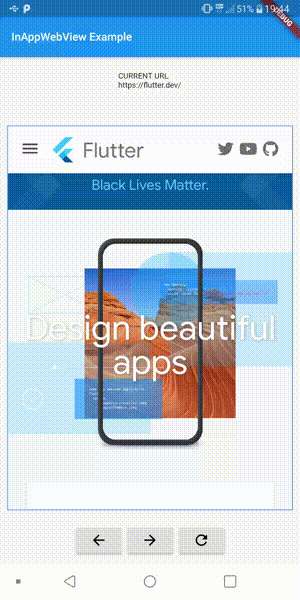
This is the full code example:
import 'dart:async';
import 'package:flutter/material.dart';
import 'package:flutter_inappwebview/flutter_inappwebview.dart';
Future main() async {
WidgetsFlutterBinding.ensureInitialized();
runApp(new MyApp());
}
class MyApp extends StatefulWidget {
_MyAppState createState() => new _MyAppState();
}
class _MyAppState extends State<MyApp> {
InAppWebViewController _webViewController;
String url = "";
double progress = 0;
Widget build(BuildContext context) {
return MaterialApp(
home: Scaffold(
appBar: AppBar(
title: const Text('InAppWebView Example'),
),
body: Container(
child: Column(children: <Widget>[
Container(
padding: EdgeInsets.all(20.0),
child: Text(
"CURRENT URL\n${(url.length > 50) ? url.substring(0, 50) + "..." : url}"),
),
Container(
padding: EdgeInsets.all(10.0),
child: progress < 1.0
? LinearProgressIndicator(value: progress)
: Container()),
Expanded(
child: Container(
margin: const EdgeInsets.all(10.0),
decoration:
BoxDecoration(border: Border.all(color: Colors.blueAccent)),
child: InAppWebView(
initialUrl: "https://flutter.dev/",
initialOptions: InAppWebViewGroupOptions(
crossPlatform: InAppWebViewOptions(
debuggingEnabled: true,
)
),
onWebViewCreated: (InAppWebViewController controller) {
_webViewController = controller;
},
onLoadStart: (InAppWebViewController controller, String url) {
setState(() {
this.url = url;
});
},
onLoadStop: (InAppWebViewController controller, String url) async {
setState(() {
this.url = url;
});
},
onProgressChanged: (InAppWebViewController controller, int progress) {
setState(() {
this.progress = progress / 100;
});
},
),
),
),
ButtonBar(
alignment: MainAxisAlignment.center,
children: <Widget>[
RaisedButton(
child: Icon(Icons.arrow_back),
onPressed: () {
if (_webViewController != null) {
_webViewController.goBack();
}
},
),
RaisedButton(
child: Icon(Icons.arrow_forward),
onPressed: () {
if (_webViewController != null) {
_webViewController.goForward();
}
},
),
RaisedButton(
child: Icon(Icons.refresh),
onPressed: () {
if (_webViewController != null) {
_webViewController.reload();
}
},
),
],
),
])),
),
);
}
}
JavaScript Handlers (Channels)
You can communicate with the JavaScript side and vice-versa. To add a JavaScript handler, you can use _webViewController.addJavaScriptHandler method, where you define the handlerName and a callback to be invoked when it is called by the JavaScript side. The callback can return data to be sent on the JavaScript side.
Instead, on the JavaScript side, to execute the callback handler and send data to Flutter, you need to use window.flutter_inappwebview.callHandler(handlerName <String>, ...args) method, where handlerName is a string that represents the handler name that your calling and args are optional arguments that you can send to the Flutter side.
In order to call window.flutter_inappwebview.callHandler(handlerName <String>, ...args) properly, you need to wait and listen to the JavaScript event flutterInAppWebViewPlatformReady. This event will be dispatched as soon as the platform (Android or iOS) is ready to handle the callHandler method.
Here is an example:
import 'dart:async';
import 'package:flutter/material.dart';
import 'package:flutter_inappwebview/flutter_inappwebview.dart';
Future main() async {
WidgetsFlutterBinding.ensureInitialized();
runApp(new MyApp());
}
class MyApp extends StatefulWidget {
_MyAppState createState() => new _MyAppState();
}
class _MyAppState extends State<MyApp> {
InAppWebViewController _webViewController;
Widget build(BuildContext context) {
return MaterialApp(
home: Scaffold(
appBar: AppBar(
title: const Text('InAppWebView Example'),
),
body: Container(
child: Column(children: <Widget>[
Expanded(
child:InAppWebView(
initialData: InAppWebViewInitialData(
data: """
<!DOCTYPE html>
<html lang="en">
<head>
<meta charset="UTF-8">
<meta name="viewport" content="width=device-width, user-scalable=no, initial-scale=1.0, maximum-scale=1.0, minimum-scale=1.0">
</head>
<body>
<h1>JavaScript Handlers (Channels) TEST</h1>
<script>
window.addEventListener("flutterInAppWebViewPlatformReady", function(event) {
window.flutter_inappwebview.callHandler('handlerFoo')
.then(function(result) {
// print to the console the data coming
// from the Flutter side.
console.log(JSON.stringify(result));
window.flutter_inappwebview
.callHandler('handlerFooWithArgs', 1, true, ['bar', 5], {foo: 'baz'}, result);
});
});
</script>
</body>
</html>
"""
),
initialOptions: InAppWebViewGroupOptions(
crossPlatform: InAppWebViewOptions(
debuggingEnabled: true,
)
),
onWebViewCreated: (InAppWebViewController controller) {
_webViewController = controller;
_webViewController.addJavaScriptHandler(handlerName:'handlerFoo', callback: (args) {
// return data to JavaScript side!
return {
'bar': 'bar_value', 'baz': 'baz_value'
};
});
_webViewController.addJavaScriptHandler(handlerName: 'handlerFooWithArgs', callback: (args) {
print(args);
// it will print: [1, true, [bar, 5], {foo: baz}, {bar: bar_value, baz: baz_value}]
});
},
onConsoleMessage: (controller, consoleMessage) {
print(consoleMessage);
// it will print: {message: {"bar":"bar_value","baz":"baz_value"}, messageLevel: 1}
},
),
),
])),
),
);
}
}
WebRTC in InAppWebView
At this moment, WebRTC is supported only on Android, because, unfortunately, on iOS WKWebView doesn't implement all the WebRTC API (you can follow this issue: #200).
I'm going to show an example using https://appr.tc/ to test WebRTC feature. It's a video chat demo app based on WebRTC (https://github.com/webrtc/apprtc).
To request permissions about the camera and microphone, you can use the permission_handler plugin. Also, you need to set the WebView option mediaPlaybackRequiresUserGesture to false in order to autoplay HTML5 audio and video.
Furthermore, on Android, you need to implement the androidOnPermissionRequest event (it's an Android-specific event), that is an event fired when the WebView is requesting permission to access a specific resource (that is the Android native WebChromeClient.onPermissionRequest event). In this case, this event is used to grant permissions for the WebRTC API. Also, you need to add these permissions in the AndroidManifest.xml:
<uses-permission android:name="android.permission.INTERNET"/>
<uses-permission android:name="android.permission.CAMERA" />
<uses-permission android:name="android.permission.RECORD_AUDIO" />
<uses-permission android:name="android.permission.MODIFY_AUDIO_SETTINGS" />
<uses-permission android:name="android.permission.VIDEO_CAPTURE" />
<uses-permission android:name="android.permission.AUDIO_CAPTURE" />
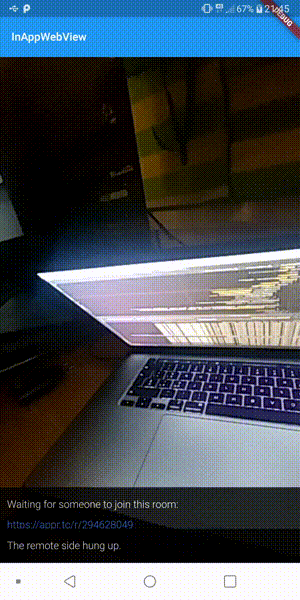
Here is the full code example:
import 'dart:async';
import 'package:flutter/material.dart';
import 'package:flutter_inappwebview/flutter_inappwebview.dart';
import 'package:permission_handler/permission_handler.dart';
Future main() async {
WidgetsFlutterBinding.ensureInitialized();
await Permission.camera.request();
await Permission.microphone.request();
runApp(MyApp());
}
class MyApp extends StatefulWidget {
_MyAppState createState() => new _MyAppState();
}
class _MyAppState extends State<MyApp> {
Widget build(BuildContext context) {
return MaterialApp(
home: InAppWebViewPage()
);
}
}
class InAppWebViewPage extends StatefulWidget {
_InAppWebViewPageState createState() => new _InAppWebViewPageState();
}
class _InAppWebViewPageState extends State<InAppWebViewPage> {
InAppWebViewController _webViewController;
Widget build(BuildContext context) {
return Scaffold(
appBar: AppBar(
title: Text("InAppWebView")
),
body: Container(
child: Column(children: <Widget>[
Expanded(
child: Container(
child: InAppWebView(
initialUrl: "https://appr.tc/r/704328056",
initialOptions: InAppWebViewGroupOptions(
crossPlatform: InAppWebViewOptions(
mediaPlaybackRequiresUserGesture: false,
debuggingEnabled: true,
),
),
onWebViewCreated: (InAppWebViewController controller) {
_webViewController = controller;
},
androidOnPermissionRequest: (InAppWebViewController controller, String origin, List<String> resources) async {
return PermissionRequestResponse(resources: resources, action: PermissionRequestResponseAction.GRANT);
}
),
),
),
]))
);
}
}
How to enable download files in InAppWebView
InAppWebView can recognize downloadable files in both Android and iOS platforms. To be able to recognize downloadable files, you need to set the useOnDownloadStart: true option, and then you can listen to the onDownloadStart event.
On Android you need to add write permission inside your AndroidManifest.xml file:
<uses-permission android:name="android.permission.WRITE_EXTERNAL_STORAGE" />
Then, you need to ask permission using the permission_handler plugin. Instead, to effectively download your file, you can use the flutter_downloader plugin. Here is a complete example using http://ovh.net/files/ (in particular, the http://ovh.net/files/1Mio.dat as URL) to test the download:
import 'dart:async';
import 'package:flutter/material.dart';
import 'package:flutter_inappwebview/flutter_inappwebview.dart';
import 'package:flutter_downloader/flutter_downloader.dart';
import 'package:path_provider/path_provider.dart';
import 'package:permission_handler/permission_handler.dart';
Future main() async {
WidgetsFlutterBinding.ensureInitialized();
await FlutterDownloader.initialize(
debug: true // optional: set false to disable printing logs to console
);
await Permission.storage.request();
runApp(MyApp());
}
class MyApp extends StatefulWidget {
_MyAppState createState() => new _MyAppState();
}
class _MyAppState extends State<MyApp> {
InAppWebViewController _webViewController;
Widget build(BuildContext context) {
return MaterialApp(
home: Scaffold(
appBar: AppBar(
title: const Text('InAppWebView Example'),
),
body: Container(
child: Column(children: <Widget>[
Expanded(
child: InAppWebView(
initialUrl: "http://ovh.net/files/1Mio.dat",
initialOptions: InAppWebViewGroupOptions(
crossPlatform: InAppWebViewOptions(
debuggingEnabled: true,
useOnDownloadStart: true
),
),
onWebViewCreated: (InAppWebViewController controller) {
_webViewController = controller;
},
onDownloadStart: (controller, url) async {
print("onDownloadStart $url");
final taskId = await FlutterDownloader.enqueue(
url: url,
savedDir: (await getExternalStorageDirectory()).path,
showNotification: true, // show download progress in status bar (for Android)
openFileFromNotification: true, // click on notification to open downloaded file (for Android)
);
},
))
])),
),
);
}
}
As you can see, I'm using also the path_provider plugin to get the folder where I want to save the file.
Allow Self-signed SSL Certificates
To allow self-signed SSL certificates, you can use the onReceivedServerTrustAuthRequest event and simply return to proceed with the request:
onReceivedServerTrustAuthRequest: (controller, challenge) async {
return ServerTrustAuthResponse(action: ServerTrustAuthResponseAction.PROCEED);
},
How to manage popup windows opened with target="_blank" or "window.open"
To manage popup windows when a user clicks on a link with target="_blank" or through JavaScript code using window.open, you can use the onCreateWindow event. On Android, to be able to allow this event, you need to set the supportMultipleWindows option to true. Also, in order to be able to allow the usage of JavaScript, you need to set the javaScriptCanOpenWindowsAutomatically to true.
If you want to manage these requests, you should return true from this event, otherwise, the default implementation of this event does nothing and hence returns false.
The CreateWindowRequest represents the navigation request which contains a windowId that can be used to create, for example, a new InAppWebView instance. This windowId is used by the native code to map the request and the WebView to be used to manage that request.
Also, CreateWindowRequest contains the url of the request (on Android, if the popup is opened using JavaScript with window.open, it will be null), but if you need to maintain the Window JavaScript object reference (created using window.open method), for example, to call window.close method, then you should create the new WebView with the windowId, without using the url.
Here is a simple example that shows an AlertDialog when the user clicks on the link:
import 'dart:async';
import 'package:flutter/material.dart';
import 'package:flutter_inappwebview/flutter_inappwebview.dart';
Future main() async {
WidgetsFlutterBinding.ensureInitialized();
runApp(new MyApp());
}
class MyApp extends StatefulWidget {
_MyAppState createState() => new _MyAppState();
}
class _MyAppState extends State<MyApp> {
Widget build(BuildContext context) {
return MaterialApp(
home: InAppWebViewPage()
);
}
}
class InAppWebViewPage extends StatefulWidget {
_InAppWebViewPageState createState() => new _InAppWebViewPageState();
}
class _InAppWebViewPageState extends State<InAppWebViewPage> {
InAppWebViewController _webViewController;
InAppWebViewController _webViewPopupController;
void initState() {
super.initState();
}
void dispose() {
super.dispose();
}
Widget build(BuildContext context) {
return MaterialApp(
home: Scaffold(
appBar: AppBar(
title: const Text('InAppWebView Example'),
),
body: SafeArea(
child: Container(
child: InAppWebView(
initialData: InAppWebViewInitialData(
data: """
<!DOCTYPE html>
<html lang="en">
<head>
<meta charset="UTF-8">
<meta name="viewport" content="width=device-width, user-scalable=no, initial-scale=1.0, maximum-scale=1.0, minimum-scale=1.0">
<meta http-equiv="X-UA-Compatible" content="ie=edge">
<title>Flutter InAppWebView</title>
</head>
<body>
<a style="margin: 50px; background: #333; color: #fff; font-weight: bold; font-size: 20px; padding: 15px; display: block;"
href="https://github.com/flutter"
target="_blank">
Click here to open https://github.com/flutter in a popup!
</a>
</body>
</html>
"""
),
initialOptions: InAppWebViewGroupOptions(
crossPlatform: InAppWebViewOptions(
debuggingEnabled: true,
// set this to true if you are using window.open to open a new window with JavaScript
javaScriptCanOpenWindowsAutomatically: true
),
android: AndroidInAppWebViewOptions(
// on Android you need to set supportMultipleWindows to true,
// otherwise the onCreateWindow event won't be called
supportMultipleWindows: true
)
),
onWebViewCreated: (InAppWebViewController controller) {
_webViewController = controller;
},
onCreateWindow: (controller, createWindowRequest) async {
print("onCreateWindow");
showDialog(
context: context,
builder: (context) {
return AlertDialog(
content: Container(
width: MediaQuery.of(context).size.width,
height: 400,
child: InAppWebView(
// Setting the windowId property is important here!
windowId: createWindowRequest.windowId,
initialOptions: InAppWebViewGroupOptions(
crossPlatform: InAppWebViewOptions(
debuggingEnabled: true,
),
),
onWebViewCreated: (InAppWebViewController controller) {
_webViewPopupController = controller;
},
onLoadStart: (InAppWebViewController controller, String url) {
print("onLoadStart popup $url");
},
onLoadStop: (InAppWebViewController controller, String url) {
print("onLoadStop popup $url");
},
),
),
);
},
);
return true;
},
),
),
),
),
);
}
}
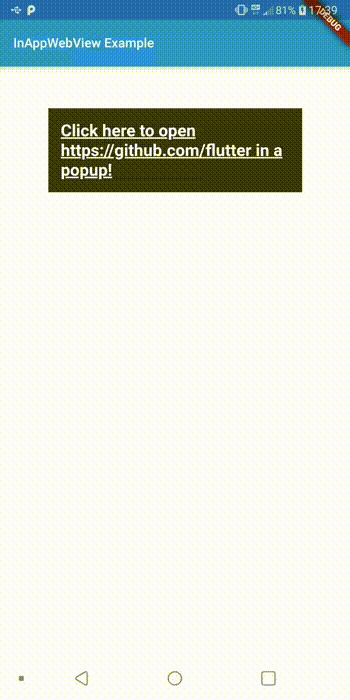
Manage platform URLs such as whatsapp:, fb:, tel:, mailto:, etc.
Generally, a WebView knows nothing on how to manage whatsapp:, tel: or fb: protocol/scheme. To capture the requests made with these custom protocols/schemes, you can use the shouldOverrideUrlLoading event (you need to enable it with useShouldOverrideUrlLoading: true option).
This way you can cancel the request made for the WebView and, instead, open the App, for example, using the url_launcher plugin:
initialOptions: InAppWebViewGroupOptions(
crossPlatform: InAppWebViewOptions(
debuggingEnabled: true,
useShouldOverrideUrlLoading: true
),
),
shouldOverrideUrlLoading: (controller, request) async {
var url = request.url;
var uri = Uri.parse(url);
if (!["http", "https", "file",
"chrome", "data", "javascript",
"about"].contains(uri.scheme)) {
if (await canLaunch(url)) {
// Launch the App
await launch(
url,
);
// and cancel the request
return ShouldOverrideUrlLoadingAction.CANCEL;
}
}
return ShouldOverrideUrlLoadingAction.ALLOW;
},
Manage WebView Cookies
To manage WebView cookies, you can use the CookieManager class, which implements a singleton object (shared instance). On Android, it is implemented using the CookieManager class. On iOS, it is implemented using the WKHTTPCookieStore class.
Here is an example of how to set a cookie:
CookieManager _cookieManager = CookieManager.instance();
final expiresDate =
DateTime.now().add(Duration(days: 3)).millisecondsSinceEpoch;
_cookieManager.setCookie(
url: "https://flutter.dev/",
name: "session",
value: "54th5hfdcfg34",
domain: ".flutter.dev",
expiresDate: expiresDate,
isSecure: true,
);
Custom context menus
You can customize WebView's context menu adding custom menu items, and/or hiding the default system menu items. For each custom menu item, you can declare a callback action to be invoked when the user clicks on it. As an example, I will add a custom menu item named Special and I will define a callback action that shows a JavaScript window.alert to the user with the text selected.
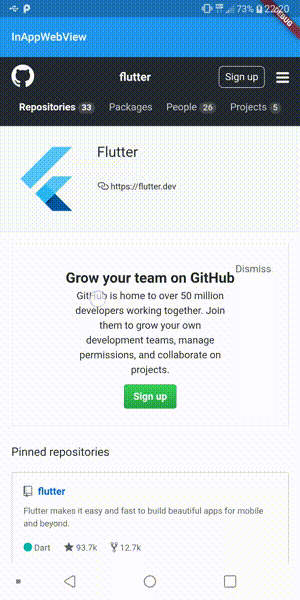
Here is the full code example:
import 'dart:async';
import 'dart:io';
import 'package:flutter/material.dart';
import 'package:flutter_inappwebview/flutter_inappwebview.dart';
Future main() async {
WidgetsFlutterBinding.ensureInitialized();
runApp(MyApp());
}
class MyApp extends StatefulWidget {
_MyAppState createState() => new _MyAppState();
}
class _MyAppState extends State<MyApp> {
Widget build(BuildContext context) {
return MaterialApp(
home: InAppWebViewPage()
);
}
}
class InAppWebViewPage extends StatefulWidget {
_InAppWebViewPageState createState() => new _InAppWebViewPageState();
}
class _InAppWebViewPageState extends State<InAppWebViewPage> {
InAppWebViewController _webViewController;
ContextMenu contextMenu;
void initState() {
super.initState();
contextMenu = ContextMenu(
menuItems: [
ContextMenuItem(androidId: 1, iosId: "1", title: "Special", action: () async {
print("Menu item Special clicked!");
var selectedText = await _webViewController.getSelectedText();
await _webViewController.clearFocus();
await _webViewController.evaluateJavascript(source: "window.alert('You have selected: $selectedText')");
})
],
options: ContextMenuOptions(
hideDefaultSystemContextMenuItems: false
),
onCreateContextMenu: (hitTestResult) async {
print("onCreateContextMenu");
print(hitTestResult.extra);
print(await _webViewController.getSelectedText());
},
onHideContextMenu: () {
print("onHideContextMenu");
},
onContextMenuActionItemClicked: (contextMenuItemClicked) async {
var id = (Platform.isAndroid) ? contextMenuItemClicked.androidId : contextMenuItemClicked.iosId;
print("onContextMenuActionItemClicked: " + id.toString() + " " + contextMenuItemClicked.title);
}
);
}
Widget build(BuildContext context) {
return Scaffold(
appBar: AppBar(
title: Text("InAppWebView")
),
body: Container(
child: Column(children: <Widget>[
Expanded(
child: Container(
child: InAppWebView(
initialUrl: "https://github.com/flutter",
contextMenu: contextMenu,
initialOptions: InAppWebViewGroupOptions(
crossPlatform: InAppWebViewOptions(
debuggingEnabled: true,
),
),
onWebViewCreated: (InAppWebViewController controller) {
_webViewController = controller;
},
),
),
),
]))
);
}
}
Conclusion
In this article, I made a little introduction to the flutter_inappwebview plugin, in particular, about the InAppWebView widget. The plugin is in continuous development (at the time of this writing, the latest release is 4.0.0+4) and I recommend you check out the API Reference to find out all the features. For any new feature request/bug fix, you can use the issue section of the repository.
The next article will be on how to implement a Full-Featured Browser using this plugin.
That's all for today! I hope it has opened new use cases for your Flutter apps.

